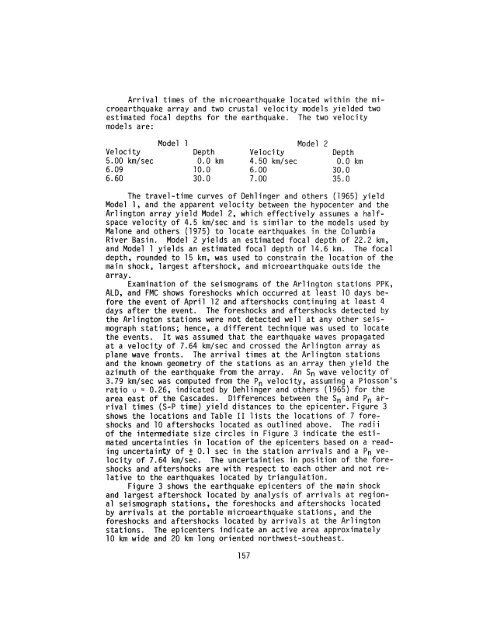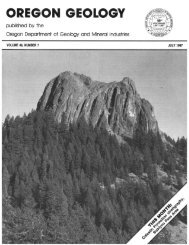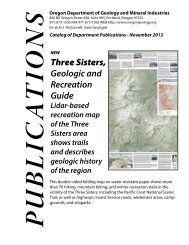The Ore Bin - Oregon Department of Geology and Mineral Industries
The Ore Bin - Oregon Department of Geology and Mineral Industries
The Ore Bin - Oregon Department of Geology and Mineral Industries
You also want an ePaper? Increase the reach of your titles
YUMPU automatically turns print PDFs into web optimized ePapers that Google loves.
Arrival times <strong>of</strong> the microearthquake located within the microearthquake<br />
array <strong>and</strong> two crustal velocity models yielded two<br />
estimated focal depths for the earthquake. <strong>The</strong> two velocity<br />
models are:<br />
Velocity<br />
5.00 km/sec<br />
6.09<br />
6.60<br />
Model 1 Depth<br />
0.0 km<br />
10.0<br />
30.0<br />
Model 2<br />
Velocity<br />
4.50 km/sec<br />
6.00<br />
7.00<br />
Depth<br />
0.0 km<br />
30.0<br />
35.0<br />
<strong>The</strong> travel-time curves <strong>of</strong> Dehlinger <strong>and</strong> others (1965) yield<br />
Modell, <strong>and</strong> the apparent velocity between the hypocenter <strong>and</strong> the<br />
Arlington array yield Model 2, which effectively assumes a halfspace<br />
velocity <strong>of</strong> 4.5 km/sec <strong>and</strong> is similar to the models used by<br />
Malone <strong>and</strong> others (1975) to locate earthquakes in the Columbia<br />
River Basin. Model 2 yields an estimated focal depth <strong>of</strong> 22.2 km,<br />
<strong>and</strong> Model 1 yields an estimated focal depth <strong>of</strong> 14.6 km. <strong>The</strong> focal<br />
depth, rounded to 15 km, was used to constrain the location <strong>of</strong> the<br />
main shock, largest aftershock, <strong>and</strong> microearthquake outside the<br />
array. Examination <strong>of</strong> the seismograms <strong>of</strong> the Arlington stations PPK,<br />
ALD, <strong>and</strong> FMC shows foreshocks which occurred at least 10 days before<br />
the event <strong>of</strong> April 12 <strong>and</strong> aftershocks continuing at least 4<br />
days after the event. <strong>The</strong> foreshocks <strong>and</strong> aftershocks detected by<br />
the Arlington stations were not detected well at any other seismograph<br />
stations; hence, a different technique was used to locate<br />
the events. It was assumed that the earthquake waves propagated<br />
at a velocity <strong>of</strong> 7.64 km/sec <strong>and</strong> crossed the Arlington array as<br />
plane wave fronts. <strong>The</strong> arrival times at the Arlington stations<br />
<strong>and</strong> the known geometry <strong>of</strong> the stations as an array then yield the<br />
azimuth <strong>of</strong> the earthquake from the array. An Sn wave velocity <strong>of</strong><br />
3.79 km/sec was computed from the P n velocity, assuming a Piosson's<br />
ratio u = 0.26, indicated by Dehlinger <strong>and</strong> others (1965) for the<br />
area east <strong>of</strong> the Cascades. Differences between the Sn <strong>and</strong> Pn arrival<br />
times (S-P time) yield distances to the epicenter. Figure 3<br />
shows the locations <strong>and</strong> Table II lists the locations <strong>of</strong> 7 foreshocks<br />
<strong>and</strong> 10 aftershocks located as outlined above. <strong>The</strong> radii<br />
<strong>of</strong> the intermediate size circles in Figure 3 indicate the estimated<br />
uncertainties in location <strong>of</strong> the epicenters based on a reading<br />
uncertainty <strong>of</strong> ± 0.1 sec in the station arrivals <strong>and</strong> a Pn velocity<br />
<strong>of</strong> 7.64 km/sec. <strong>The</strong> uncertainties in position <strong>of</strong> the foreshocks<br />
<strong>and</strong> aftershocks are with respect to each other <strong>and</strong> not relative<br />
to the earthquakes located by triangulation.<br />
Figure 3 shows the earthquake epicenters <strong>of</strong> the main shock<br />
<strong>and</strong> largest aftershock located by analysis <strong>of</strong> arrivals at regional<br />
seismograph stations, the foreshocks <strong>and</strong> aftershocks located<br />
by arrivals at the portable microearthquake stations, <strong>and</strong> the<br />
foreshocks <strong>and</strong> aftershocks located by arrivals at the Arlington<br />
stations. <strong>The</strong> epicenters indicate an active area approximately<br />
10 km wide <strong>and</strong> 20 km long oriented northwest-southeast.<br />
157









